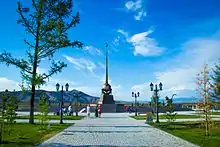Siberian Federal District
Siberian Federal District (Russian: Сиби́рский федера́льный о́круг, Sibirsky federalny okrug) is one of the eight federal districts of Russia. Its population was 17,178,298 according to the 2010 Census,[2] living in an area of 4,361,800 square kilometers (1,684,100 sq mi).[1] The entire federal district lies within the continent of Asia.

Siberian Federal District
Сибирский федеральный округ | |
|---|---|
.svg.png.webp) Location of the Siberian Federal District | |
| Country | |
| Established | 18 May 2000 |
| Administrative centre | Novosibirsk |
| Government | |
| • Presidential Envoy | Sergey Menyaylo |
| Area | |
| • Total | 4,361,800 km2 (1,684,100 sq mi) |
| Area rank | 2nd |
| Population (2010) | |
| • Total | 17,178,298[2] |
| • Rank | 3rd |
| • Density | 3.8/km2 (10/sq mi) |
| Time zones | |
| Omsk Oblast | UTC+06:00 (Omsk Time) |
| most of the district | UTC+07:00 (Krasnoyarsk Time) |
| Irkutsk Oblast | UTC+08:00 (Irkutsk Time) |
| Federal subjects | 10 contained |
| Economic regions | 2 contained |
| HDI (2018) | 0.796[3] high · 7th |
| Website | sfo.gov.ru |
The district was created by presidential decree on 13 May 2000 and covers around 30% of the total land area of Russia.[4] In November 2018, Buryatia and Zabaykalsky Krai were removed from the Siberian Federal District and added to the Far Eastern Federal District in accordance with a decree issued by Russian President Vladimir Putin.[5]
Demographics
Federal subjects
The district comprises the West Siberian (part) and East Siberian economic regions and ten federal subjects:
.svg.png.webp) | |||||
|---|---|---|---|---|---|
| # | Flag | Federal subject | Area in km2[1] | Population (2010) | Capital/Administrative center |
| 1 | Altai Republic | 92,900 | 206,168 | Gorno-Altaysk | |
| 2 | Altai Krai | 168,000 | 2,419,755 | Barnaul | |
| 3 | Irkutsk Oblast | 774,800 | 2,248,750 | Irkutsk | |
| 4 | Kemerovo Oblast | 95,700 | 2,763,135 | Kemerovo | |
| 5 | Krasnoyarsk Krai | 2,366,800 | 2,828,187 | Krasnoyarsk | |
| 6 | Novosibirsk Oblast | 177,800 | 2,665,911 | Novosibirsk | |
| 7 | Omsk Oblast | 141,100 | 1,977,665 | Omsk | |
| 8 | Tomsk Oblast | 314,400 | 1,047,394 | Tomsk | |
| 9 | Tuva Republic | 168,600 | 307,930 | Kyzyl | |
| 10 | Republic of Khakassia | 61,600 | 532,403 | Abakan | |

Religion
According to a 2012 survey[6] 28.9% of the population of the current federal subjects of the Siberian Federal District (excluding Buryatia and Zabaykalsky Krai) adheres to the Russian Orthodox Church, 5.2% are unaffiliated generic Christians, 1.9% is an Orthodox believer without belonging to any church or adheres to other (non-Russian) Orthodox churches, 1.4% is an adherent of Islam, 1.2% is an adherant of Buddhism, and 1.6% adhere to some native faith such as Rodnovery, Tengrism, or Tuvan Shamanism. In addition, 33.2% of the population declares to be "spiritual but not religious", 18.7% is atheist, and 7.9% follows other religions or did not give an answer to the question.[6]
Presidential plenipotentiary envoys
- Leonid Drachevsky (18 May 2000 – 9 September 2004)
- Anatoly Kvashnin (9 September 2004 – 9 September 2010)
- Viktor Tolokonsky (9 September 2010 – 12 May 2014)
- Nikolay Rogozhkin (12 May 2014 – 28 July 2016)
- Sergey Menyaylo (since 28 July 2016)[8]
See also
References
- "1.1. ОСНОВНЫЕ СОЦИАЛЬНО-ЭКОНОМИЧЕСКИЕ ПОКАЗАТЕЛИ в 2014 г." [MAIN SOCIOECONOMIC INDICATORS 2014]. Regions of Russia. Socioeconomic indicators - 2015 (in Russian). Russian Federal State Statistics Service. Retrieved July 26, 2016.
- Russian Federal State Statistics Service (2011). "Всероссийская перепись населения 2010 года. Том 1" [2010 All-Russian Population Census, vol. 1]. Всероссийская перепись населения 2010 года [2010 All-Russia Population Census] (in Russian). Federal State Statistics Service.
- "Sub-national HDI - Area Database - Global Data Lab". hdi.globaldatalab.org. Retrieved March 18, 2020.
- "Siberia Federal District, Russia (Siberian)". RussiaTrek.org. Retrieved July 15, 2012.
- "Официальный интернет-портал правовой информации". publication.pravo.gov.ru. Retrieved November 4, 2018.
- "Arena: Atlas of Religions and Nationalities in Russia". Sreda, 2012.
- 2012 Arena Atlas Religion Maps. "Ogonek", № 34 (5243), August 27, 2012. Retrieved April 21, 2017. Archived.
- "Путин освободил Меняйло от должности губернатора Севастополя" (in Russian). Echo of Moscow. July 28, 2016. Retrieved July 28, 2016.